Army Ground Intelligence Support Activity Gisaeng Story

The United States Army Intelligence Support Activity (USAISA) So, on 3 March 1981, the FOG was established as a permanent unit and renamed US Army Intelligence Support Activity.[4] This activity should not be confused with a later activity known as the Ground Intelligence Support. The United States Army Intelligence Support Activity. The administration saw that ground intelligence contingencies needed to. The Inside Story of America.
In a dark corner of American special operations there exists, alongside the Army's Delta Force and the Navy's Osama bin Laden-killing SEAL Team Six, a small unit of Army spies known as the Intelligence Support Activity. Created more than 30 years ago, the ISA has had its hand in almost every high-profile American special operation around the world in recent history, and countless others, according to published reports and special operations veterans with firsthand knowledge of the group. And though relatively little is known about the secret unit -- the military still refuses to acknowledge its existence -- a new, colorful picture of the group has emerged through, of all things, a comic book. In the panels of the comic ',' writer Nathan Edmondson and artist Mitch Gerads create a cell-shaded version of the ISA's world in which the plot is fictional, but much of the rest rings true, even to those few familiar with the comic's real-life counterpart. One former member of the special operations community, who requested anonymity to speak about the ISA, told ABC News that while the comic clearly condenses intelligence-gathering timelines and significantly expands the ISA's duties for the sake of dramatic story telling, he was surprised at its overall accuracy. 'There's a lot more gunplay [in the comic] and a lot less of the mundane day-to-day intelligence collection,' he said. '[But] the mission profiles, the types of missions are accurate.
They [the writers] actually do know the unit to which they're referring.' That's likely because Edmondson said the comic is written with input from current and former members of the broader community of America's military elite.
'Half [of the comic] is based on or lifted from real stories,' Edmondson told ABC News. 'The mission may not be real, but it's not outside the realm of possibility.' For example, to write one sequence, Edmondson said he reached out to a group of Navy SEALs and asked them how they would conduct a certain operation.
Efficiency of cuk converter equations of parallel. He said the SEALs were happy to help him make the story as accurate as possible without giving away any operational secrets. More than once Edmondson said he made up a storyline or piece of technology only to be quietly asked by his military acquaintances not to include it in the comic -- he had accidentally stumbled too close to the truth. Jack Murphy, a former Special Forces soldier and Managing Editor at the special operations website, told ABC News that he helped Edmondson with some of the military chatter and lingo that the characters use in the comic.
'It's important to get it right. People are a lot smarter [about special operations],' he said. 'It's not giving away operational secrets or anything like that.' A comic or book done well, Murphy said, 'gives credit to the soldier on the ground, the one working behind the scenes,' without putting him in danger.
'We Don't Know a Lot About What These Guys Do' According to the about the ISA, and the smattering of newspaper articles over the last 30 years that have identified the unit, the Intelligence Support Activity began in the early 1980s after the military's during the Iran Hostage Crisis. One of the many lessons the military took from that deadly incident was that the CIA's intelligence gathering efforts often did not extend to some very specific, tactically-oriented information that would be necessary to launch clandestine military operations. So rather than rely on the Agency, the military went about setting up its own intelligence-gathering network around the globe and created the ISA to be its specialists in human and signals intelligence. Often, the ISA's job resembles the work of the CIA: They enter foreign countries under cover identities, track persons of interest both on foot and using sophisticated signals interception technology and, depending on the mission, potentially pave the way for the 'door kickers' – meaning the 'shooters' of SEAL Team Six or Delta Force – to come in for more hands-on action. Many of their missions are designed to give the U.S.
Government total deniability, according to the former special operations service member. The New York Times first revealed the ISA's existence back in 1983 and the unit has since found its way into the public light in brief spurts ever since for their reported role in everything from joint American-Colombian in the 1990s to secret in the Horn of Africa in the 2000s. 'The missions are wide-ranging, that's one of the hardest parts about the job,' the ex-special operations service member said. But unlike Delta Force, which was the subject of several action movies in the late 1980s and early 1990s as well as a more recent television series, and SEAL Team Six, the interest in which skyrocketed after U.S. Officials revealed that was the unit that conducted the raid that in May 2011, the ISA has managed to keep a relatively low profile.
- вторник 08 января
- 25